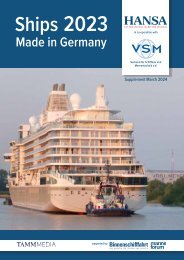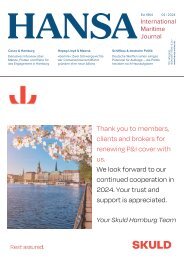HANSA 05-2020
BunkerTrace | Shipmanagement & COVID-19 | Griechenland | Tanker-Schifffahrt | Offshore-Wind | Briese Chartering | Interview Thomas Press | United Heavy Lift | MPP-Schiffe & Ladungen
BunkerTrace | Shipmanagement & COVID-19 | Griechenland | Tanker-Schifffahrt | Offshore-Wind | Briese Chartering | Interview Thomas Press | United Heavy Lift | MPP-Schiffe & Ladungen
Create successful ePaper yourself
Turn your PDF publications into a flip-book with our unique Google optimized e-Paper software.
Märkte | Markets<br />
Pandemic knocks down boxship rates<br />
The impact of large-scale lockdowns on the container trades intensifies, with tonnage<br />
overcapacity surging and employment prospects dwindling. By Michael Hollmann<br />
Although the freeze of western economies<br />
is gradually thawing thanks to<br />
cautious lifting of quarantine measures,<br />
the immediate prospects for shipping<br />
continue to worsen. Up until April, cargo<br />
flows in the container sector appeared<br />
to be holding up relatively well.<br />
A lot of merchandise, ordered and produced<br />
before the pandemic, still had to<br />
be shipped. Now the grace period is over,<br />
cargo volumes are disappearing at an<br />
alarming rate. By how much trade volumes<br />
are going to be slashed this year is<br />
everyone’s guess. Shipping analysts have<br />
come up with estimates of -7% to -10%<br />
for global loaded container traffic.<br />
However, these can be considered no<br />
more than »spur of the moment« projections<br />
given that the global economic implications<br />
of the pandemic are still hard<br />
to grasp. The situation is so volatile that<br />
even multinational agencies are making<br />
large caveats to their forecasts.<br />
The World Trade Organisation (WTO)<br />
expects world trade to drop anywhere between<br />
13% and 32% this year, the International<br />
Monetary Fund (IMF) ventures<br />
a more modest -11% contraction for<br />
trade. The short-term impact is far more<br />
severe, with purchasing manager indices<br />
for Europe and the US – the biggest<br />
import markets for container shipping –<br />
dropping like a stone in April.<br />
Freight rates still up year-on-year<br />
Container lines are blanking more sailings<br />
by the week. The tally of withdrawn<br />
sailing capacity has reached 30% in the<br />
Far East/Europe trade for the coming<br />
weeks. As freight forwarders currently<br />
report tight space availability for cargo<br />
bookings, the fall in actual trade volumes<br />
might well be around the level of<br />
the blanked capacity.<br />
The carriers’ efforts have been reasonably<br />
successful in maintaining freight<br />
rates, with the World Container Index<br />
(WCI) by Drewry assessing average spot<br />
rates in the east/west trades almost unchanged<br />
month-on-month as per end of<br />
April, but up 11% year-on-year. To prevent<br />
a collapse in revenue, it is absolutely<br />
essential for container lines to efficiently<br />
manage their capacity and maximise<br />
freight rates.<br />
In unserem Portal <strong>HANSA</strong>+ vereinen wir<br />
eine Übersicht wichtiger Kennzahlen der<br />
Märkte. Sichern Sie sich den Zugriff auf<br />
Fracht- und Charterraten in der Container-,<br />
Bulk- und Tank schifffahrt, Bunkerpreise,<br />
MPP-, Shortsea- und Umschlagindizes,<br />
Ölpreise und vieles mehr …<br />
Erfahren Sie mehr über alle Optionen<br />
jederzeit unter www.hansa-online.de.<br />
Much of the burden of overcapacity<br />
will be passed on to non-operating owners.<br />
After a prolonged period of resilience,<br />
the charter market for container<br />
ships came under intense pressure during<br />
April. Redeliveries of charter ships<br />
gathered momentum as carriers prioritise<br />
their own vessels.<br />
In line with another surge in idle fleet<br />
capacity, the pool of unemployed spot<br />
ships expanded rapidly. As per 20 April,<br />
Alphaliner counted 183 container ships<br />
available on spot basis, against only<br />
115 four weeks prior. Panamaxes, gearless<br />
2,700/2,800 TEU, midsize 1,600-<br />
1,800 TEU and the smallest feeder vessels<br />
below 1,000 TEU recorded the steepest<br />
increases in spot tonnage.<br />
Consequently, charter rates began to<br />
slip more quickly, with the New ConTex<br />
showing a 6% drop month-on-month for<br />
»normal« periods. Fixing levels for shorter<br />
and flexible periods which are the order<br />
of the day, are dropping even faster.<br />
Big ships – big falls<br />
Notably, large gearless vessels of<br />
post-panamax dimensions are coming<br />
under heavy pressure now. The latest reported<br />
fixture was the 7,241 TEU »Adrian<br />
Schulte« at 18,000 $/day for 4-6 months to<br />
Global Feeder Shipping – down 30% on<br />
market levels during February. Further,<br />
another modern 6,900 TEU ship reportedly<br />
accepted upper 17,000’s $/day for<br />
2-3 months which was 10,000 $ less than<br />
a sister had fixed in late February.<br />
London broker Howe Robinson saw<br />
charter rates for post-panamax ships<br />
drop by a staggering 7.5-9.1% within just<br />
one week. MSI predicts rate levels for<br />
8,500 TEU and 6,500 TEU ships to fall to<br />
12,500 $/day and 11,400 $/day by August<br />
– half of what they were back in February.<br />
Pressure on rates for these big vessels is<br />
likely being compounded as carriers offer<br />
their own ships as relets and as more<br />
units return from scrubber installations<br />
at shipyards, brokers warn.<br />
For most of the classes below 5,000 TEU,<br />
the downward trend has not been quite<br />
as sharp. Baby panamax container ships<br />
of 4,250 TEU capacity suffered a deterioration<br />
from high 11,000’s $/ay to around<br />
10,000 $/day in Asia over the past month.<br />
Owners of gearless 2,700/2,800 TEU<br />
ships – described by brokers as the most<br />
active segment despite a rise in tonnage<br />
availability – managed to limit losses to<br />
around 500 $. Aker/Thyssen types were<br />
still achieving around 9,000 $/day in Asia,<br />
Hyundai Mipo types around 8,500 $/day<br />
– all still comfortably above opex.<br />
For the smaller handy types below<br />
2,000 TEU, market conditions are deteriorating<br />
rapidly now driven by tonnage redeliveries<br />
in the Atlantic as well as in Asia.<br />
Owners of modern economic 1,700 TEU<br />
ships like the Topaz type are forced to<br />
back-pedal, with fixing levels sliding below<br />
10,000 $/day in Asia just after having<br />
recovered to 10,500 $/day.<br />
n<br />
8 <strong>HANSA</strong> – International Maritime Journal <strong>05</strong> | <strong>2020</strong>


















